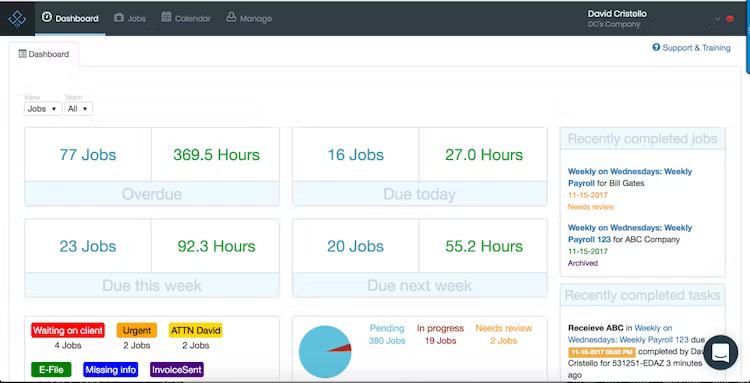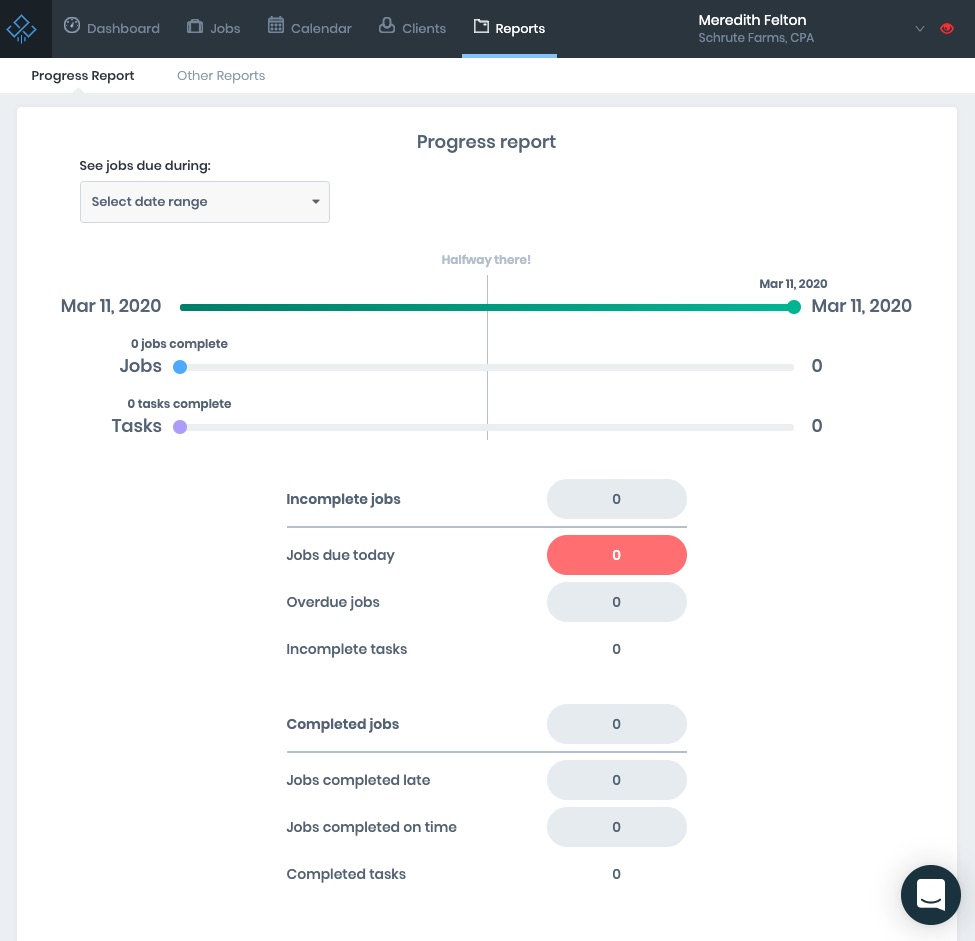Top 7 Aero Workflow Alternatives to Manage Workflows [2024]

Aero Workflow is an accounting practice management software solution designed by accountants for accountants. The tool is designed to merge processes and procedures with daily tasks to ensure efficiency across all areas of the business.
If you’re an accountant running a growing firm and you have distributed team members, you’re likely considering Aero Workflow as a potential solution to the common challenges you are facing: tracking, organization, reporting.
Unlike back in 2008 when Aero Workflow was founded, today in 2023, there are multiple options for workflow software designed specifically for accounting and bookkeeping firms. If you’re finding the features of Aero Workflow aren’t exactly what you’re looking for, or you’re hoping for additional benefits in your chosen project management software, we did the research for you.
Here’s a list of seven best Aero Workflow alternatives to help you make the best decision on which accounting software tool is the ideal fit for your small business as you scale.
Shortcomings of Aero Workflow
Why consider options beyond Aero Workflow? Some users report a few key areas they were unsatisfied with the software.
- User experience/Ease of use: Think about it. Do you want to spend more time figuring out how to track time or log a task, or more time actually getting the work done? According to a Capterra user, “The interface was clunky and hard to navigate. It was very cumbersome and time-consuming to set up.”
Not only will this make the ramp up period harder on you, you’ll likely have to spend additional time training team members – valuable time that could be better spent on client work.
- Reporting: One of the main benefits you’ll gain from moving your workflows to a software is the ability to track and generate reports…but only if the platform you choose has the capability to show the data you’re looking for, the way you’d like it represented.
Regarding Aero Workflow, one Capterra review said, “I could not find a way to get a dashboard showing me actual logged hours vs. estimated hours by client for each month. Reports were hard to use.”
- Customer service and onboarding: Some users have reported a lack of customer support when they’ve run into issues or had questions, and others describe a difficult learning curve that stalls the complete integration of the tool into daily use practices.
The 7 Best Aero Workflow Alternatives
What other accounting software options could potentially fill any gaps left by Aero Workflow? Here’s a comprehensive rundown of the best workflow software solutions for your accounting practice.
Jetpack Workflow

- What is it: Jetpack Workflow is an emerging top choice for two key reasons. First, it’s easy to onboard and ramp up operations because it’s built with a number of free templates already loaded into the system. Second, it’s proven to increase accounting efficiency and save time: most teams report at least 10 hours saved a week.
- Top features: Integrate with over 2,000 apps using Zapier. Connect QuickBooks Online to make sending invoices a cinch. Forward emails from your inbox to automatically create tasks for you or your team.

- Who it’s for: This tool is ideal for accounting teams, bookkeeping practices, and even small business owners who are interested in automation and workflow management software that makes their lives easier.
- Pricing: Jetpack Workflow offers two plan options. The baseline plan is called the “Organize” plan, running at $45/user per month. The “Scale” plan costs $49/user per month. Both plans include unlimited storage, making document management easy, and include the automated workflows and template library. Both plans have workflow features and the pre-loaded template library.
You’re able to trial Jetpack Workflow with 14 days free, and if you go for the “Scale” plan, you’ll see the capacity management and scheduling features not available in the lower-priced option.
- Final word: A modern software solution with a much faster adoption curve, accounting teams with an immediate need for workflow automation will find success with Jetpack Workflow.
Canopy
- What is it: Canopy is a cloud-based accounting practice management tool designed to help business owners streamline their firm’s activities. It also provides a way for accountants to interact with their clients within the platform, offering a CRM feature that could create an all-in-one experience that streamlines your tool stack.
- Top features: Canopy has built-in time tracking, invoicing capability, and integrates with QuickBooks Online. Canopy has automation capability, templates, and different filters and views to help you see what’s pending and what’s complete. You can also accept payments in Canopy.
- Who it’s for: Tax and accounting firms are a good fit for Canopy, especially if you’re looking for a tool that does more than just workflow. But keep in mind that it does a little bit of everything, and some users report it falls short on the workflow front – a trade-off for access to some other features like accepting payments and the CRM capability.
- Pricing: Canopy’s pricing can be difficult to understand. They present different “modules” you can choose from. The workflow module is $35 per user per month. Additional modules such as document management and time & billing can be purchased separately ($40 per user per month and $25 per user per month, respectively). Additionally, you are charged separately depending on how many contacts you have in your database, and the cost can add up quickly.
- Final word: Canopy is a good choice for mid-sized accounting firms. The main drawback is the way pricing is structured, and some reported clunkiness with task assignment and management. And if a big part of your search for a tool is future planning and capacity management, it may not be a fit for you.
Financial Cents
- What is it: Financial Cents is another accounting practice management tool specifically designed for accountants.
- Top features: You can do nearly everything in one platform with Financial Cents – time tracking, billing, invoicing, workflows, and more. It also has a document management feature to make storing key information easy.
- Who it’s for: The tool is good for CPAs, bookkeepers, and accountants that are ready to automate key parts of their workflow, and have one place to track work and bill clients.
- Pricing: You have two plan options (Team and Scale). You can choose the monthly billing route and pay $49 per user per month or $69 per user per month (respectively), or pay on an annual basis, at $39 per user per month or $59 per user per month (respectively).
- Final word: Financial Cents’ major drawback is the lack of integrations. While you can connect to QuickBooks Online, that’s it. So if you have other tools you’d like to keep in your processes, it may not be the best fit.
Karbon
- What is it: Karbon markets itself as a collaboration platform for teams in the accounting field or other professional business services. It’s a place to track work and communicate about deadlines.
- Top features: Karbon offers performance analytics on your team, email insights, workflow automation, and client management capabilities.
- Who it’s for: Given the focus on collaboration and team optimization, it’s a good choice for larger, distributed teams with the need to balance many competing priorities at scale.
- Pricing: You have three different plan options with Karbon. The most basic is the “Team” plan, at $59 per user per month if paid annually. The “Business” plan is a bit more expensive at $79 per user per month on an annual basis. Then you must contact Karbon to access “Enterprise” level pricing.
- Final word: If you’re just starting to scale, Karbon may be too comprehensive for your needs, but if you have a larger team already, it may be a good fit for you. Keep an eye out for hidden fees and additional setup costs.
CS Professional Suite
- What is it: CS Professional Suite is both a local and cloud-based accounting firm project management tool. It’s central purpose is to streamline administrative work.
- Top features: From time tracking, to client management, to document management, it’s a good solution if you’re looking for a basic way to track time and manage your employees.
- Who it’s for: Tax professionals, accountants, and bookkeepers alike all use CS Professional Suite.
- Pricing: You must contact Thomson Reuters for pricing.
- Final word: Users report an outdated experience and clunky design. If you are looking for a streamlined, modern tool, check other options.
Asana
- What is it: Asana is a popular project management tool used in a variety of industries. One of its greatest benefits is you can use it cross-functionally across an organization, because it’s extremely easy to customize.
It also provides a level of flexibility for the average user. They can view their work in a list view, board view, or as a calendar. It caters to individual preferences, while giving project owners insight into progress as a whole.
- Top features: It’s easy to create tasks and task dependencies in Asana, which is a key part of designing a useful workflow. You can make mass updates to groups of tasks, and quickly set recurring tasks.
- Who it’s for: Asana’s primary group of users is sales and marketing teams, but it’s also used by IT, finance, and non-profit groups as well. Given its flexibility, it’s an easily adaptable choice for most companies.
- Pricing: Pricing plans start at free. You can have up to 15 team members, see different views – including lists, boards, and calendar view – and create unlimited tasks. But to get access to custom fields, private projects, custom templates, and many other features, you’ll need to upgrade to the premium plan, which is $13.49/user per month.
If you go up a level to the business plan, you’ll be able to access more advanced integrations, workload planning, and other premier features. The cost is $30.49/user per month.
- Final word: Asana’s widespread appeal lies in its accessibility. It is customizable for any industry and type of team.
However, this is also the weakness, particularly for accounting or bookkeeping company owners who wish to quickly set up their team with workflows that reflect the type of work they do. You may find yourself spending a lot of time on the setup process, which takes away from time spent on client work.
Monday.com
- What is it: Much like Asana, Monday.com is a popular choice for teams in many industries. It’s a flexible way to collaborate across different parts of an organization.
- Top features: The platform’s analytics are strong, and they pre-load many workflow templates, giving you the option to choose which are best for you without having to build from scratch.
- Who it’s for: Given it’s flexibility, teams in all industries use it. One of the top is Human Resources, but sales, marketing, and operations teams also leverage it frequently.
- Pricing: The pricing is varied across five different plans. If you’re just looking for a tool for you, it’s free. But for teams, you’ll pay anywhere from $8 to $16 per user per month, then there’s also a custom-priced enterprise plan.
- Final word: Customization is key to success with Monday.com. It’s a benefit for many, but be prepared to set up your own workflows and do a lot of leg work to get the tool tailored to your team’s processes.





